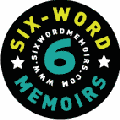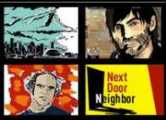Catastrophe, Crisis, and Other Family Traditions: The Photos of Jessamyn Lovell
July 1st, 2007 by kathyJessamyn Lovell’s series, Catastrophe, Crisis, and Other Family Traditions, is a family portrait that is sure to strike a nerve with almost everyone. The Oakland, CA-based photographer’s work takes an honest look at her family, flaws and all. Lovell, a professor at Diablo Valley College in Pleasant Hill, CA, began photographing her family as a way of coping with the “stress, frustration, anxiety, and guilt” she felt due in part to her home life. Lovell has created 10 different photo albums—albums dedicated to a family member, their home in upstate New York, animals, landscapes, or even Lovell herself. “When I recognized that I was part of them, and therefore partly my own subject, I started to turn the camera upon myself more and more,” she says.
Each of the 30-year-old photographer’s frames evokes something different from the common (Klare ready to eat) to the intense (Mommy taking insulin) to the off-beat (Allsun with chef knife). Lovell’s work is reminiscent of Sherwood Anderson’s wonderful book, Winesburg, OH: both allow outsiders to enter a world that’s incredibly complex, compelling, tragic, and touching.
SMITH talked to Lovell about Catastrophe, Crisis, and Other Family Traditions—and her mother’s gun, too. —Kathy Ritchie
What camera do you work with?
I use a variety of cameras. My mother gave me a Pentax K1000 when I graduated from high school because I had been using a loaner throughout my senior year. At the start of grad school, I got a Calumet 4×5 and use that a great deal still. I also use Holgas and a Diana, but I primarily use my Mamiya 7 and Contax G2 now.
Why did you decide to capture your family on film the way you did?
I began photographing my family not as subjects, but as sort of way to survive the pain I was experiencing. I used my camera as a journal of sorts to negotiate a relationship with them. [Eventually] I stopped seeing my family members so much as one entity and considering each individual more separately. I also stopped looking at them from the other side of my lens and started to record the relationship that exists between all of us, as well as the stories that have unfolded throughout our history.
This project has shifted to become a way to explore and record our collective history, as well as the choices and paths we take as individuals.
There are sets of photos of various family members, which is your favorite?
I love each set for different reasons. At times, I think the ones of my brother are the strongest because it clearly shows him growing and changing over time. My all-time favorite image has got to be “Mommy with gun” because it shows her defiance and independence, while still showing her vulnerability.
What’s the message here?
I see my work as a personal documentation of an American family struggling with class, religion, and disability. Although I deal directly with these issues, a wide variety of viewers can relate to family tragedy and crisis. The essay also looks at the daily lives of my sisters, adopted brother, mother, and my relationships with each of them. I am investigating the relationships within the family, as well as each member’s ability to transcend the circumstances we were given. I feel that by allowing the world access to this self-examination, viewers are able to gain a better understanding of disability and poverty.
Your site is very personal and very intense. How have strangers responded to your words and images?
I’ve recently realized just how vulnerable a body of work like this makes me, especially with such detailed information so publicly accessible. Many people have responded with stories of their own and want to make a connection or hear more stories. Overall, most folks who respond to my site seem to enjoy reading about the stories and relating them to the images. This is exactly what I hope to do with the book I am working on.
And how has your family reacted to your work?
My whole family—especially my mother—has been very supportive of my project and genuinely seems to understand why I’m driven to make and show the work. It’s my version of our story, but I include their words and collaborate with them to get a fuller sense of the stories and histories, even as they unfold. My sister Allsun was most against my photographing, and even stayed out of the images for a period of several years. As the project has unfolded, and she has really examined what I am doing. She has said that she is proud that I’ve taken our experiences and turned them into something positive. I can honestly say that this project has brought me closer to my family, especially my mother.
What makes a good image to you?
Content and concepts that are important to the photographer is crucial for a strong photograph. An image that that stands out and creates a reaction in the viewer. It can be ever so subtle or dramatic and jarring. Either way, a good image usually serves as a window into another world or way of thinking.
What do you consider off-limits to shoot?
When someone asks me to put the camera away or not to include [him or her] in the frame.
What’s the funniest or strangest thing you’ve seen through your viewfinder?
My sister Klare pumping up the tires of my mother’s wheelchair in Wal-Mart with a borrowed tire pump.
What’s the one fish that got away?
It was spring when Mommy first decided to finally sell all of the animals. A local farmer came with a big truck to take the 25 plus goats, one donkey, and Don Jose, our pet llama. My brother, AJ, helped round them up and herd them into the truck. Everyone got in except for Don Jose. They tried really hard—they even tried shooting him with a tranquilizer gun. The farmers got tired and finally said they would come back soon to get the remaining llama. Weeks went by and the farmer never came, so Don Jose remained in the yard.
It was around that time that Don Jose first started getting out. We could see him leap very high into the air, clearing the wire fence again and again. He was just too quick and too large to catch. A neighborhood farmer became impatient with our family for allowing the llama to roam the neighborhood. Don Jose was apparently caught several times wandering into this farmer’s bean field. The farmer told us that the next time he caught Don Jose in his bean field he would shoot him.
Sure enough, we were driving home and we caught a glimpse of the farmer chasing our llama with a shotgun at the ready! We all paused and Mommy started to cry. Shots rang out, and suddenly out of nowhere, Don Jose came running up to our house. I quickly corralled him into the fence and shut the gate. The farmer came up the road and into our yard yelling. He was obviously drunk and really pissed off, not to mention waving his shotgun around at us.
From whom, what, or where do you derive inspiration?
The works of photo greats like Diane Arbus, Robert Frank, Henri Cartier-Bresson, William Eggleston, August Sander, as well as many of my peers, friends, family, and the struggle people go through day to day just to survive. My students.
What’s the picture you’d most like to take?
My brother in his true element—away from the family.
If anyone could take a picture of you, who would you want it to be?
August Sander or Diane Arbus.
Where are you happiest taking photographs?
Cheesy places like in the woods or on the beach.
Is photography your only full-time gig?
I consider myself to be both a photographer and an educator. I just finished my first year in a full-time tenure track teaching position at Diablo Valley College in the San Francisco Bay Area. My position at DVC feeds my career, as a photographer and vice versa.
What are the sites, photocentric or not, that you most love online?
Boingboing; Magnum Photos; Alec Soth; Salon; Conceptual Art; We Make Money No Art; Coupland.com; Banksy; No One Belongs Here More Than You; Wooster Collective.com; CocoRosieLand.com.




